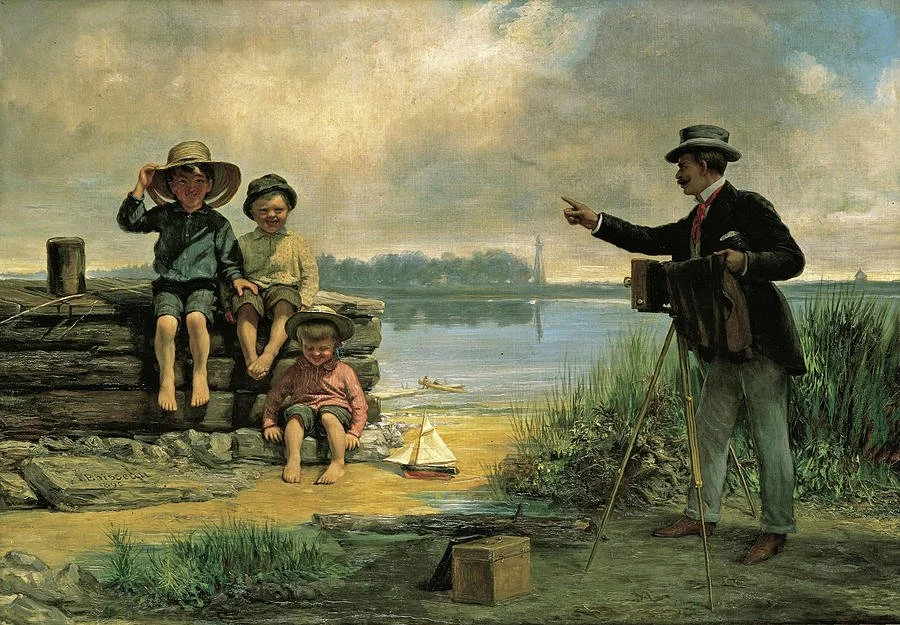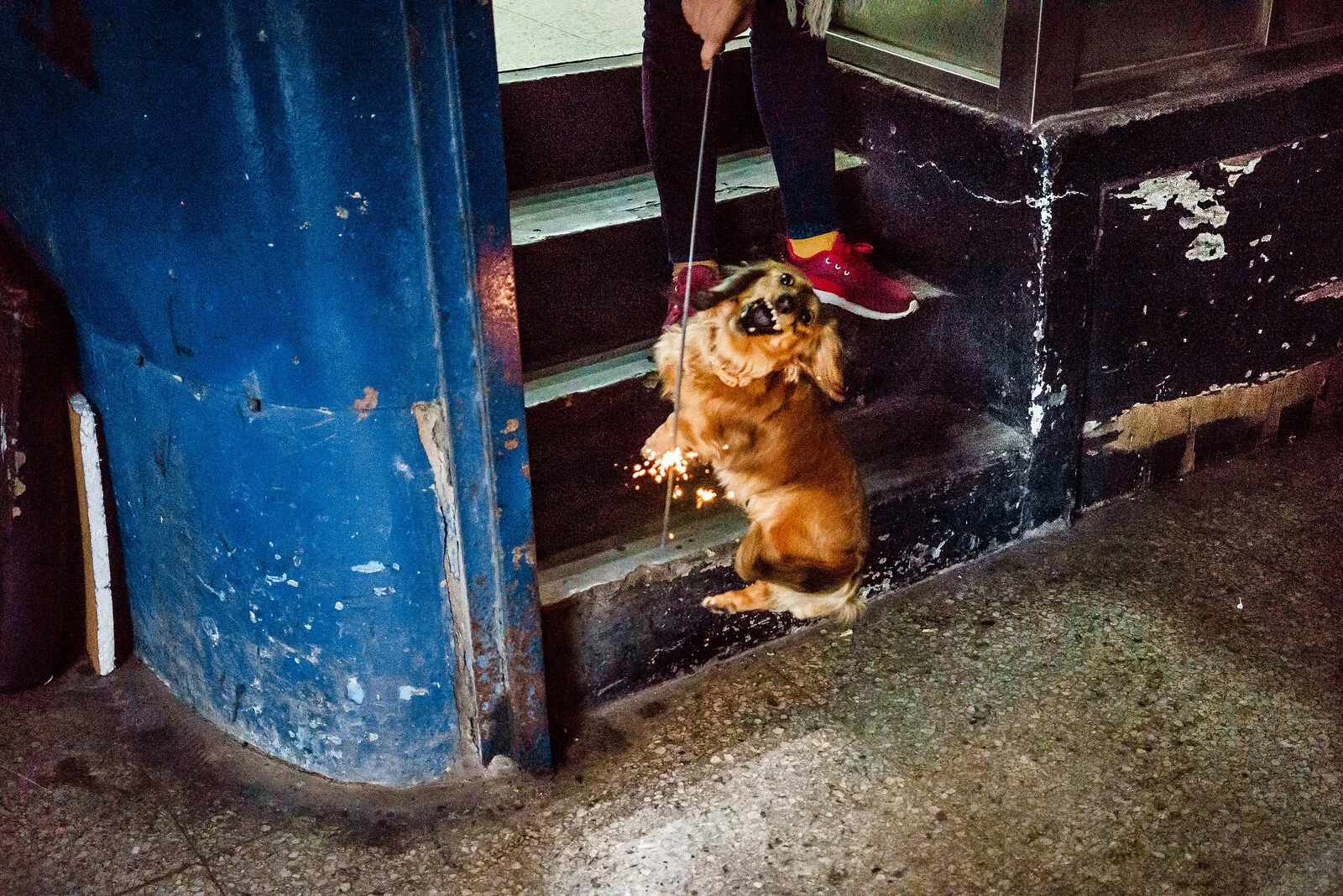A quick scan of street photography workshops online these days will inevitably reveal a bizarre emphasis on fear: “Conquer your fear!” they cry. “Overcome your fear!” or “Get over your fear (in five easy steps!)”
It would seem to be one of the basic tenets of street photography instruction, yet I feel that there is a potentially harmful misconception in many street photography circles that the practice somehow requires photographers to be “brave” and “bold”, implying that one is performing some feat of great intrepidity, engaging in a competitive challenge full of strutting machismo rather than the contemplative exercise I’ve found it to be, where bravery of the intellectual and emotional varieties are much more useful in challenging one’s own preconceptions as well as those of others. The Internet coaches, rather, tend to describe SP in hunting-related terms, making getting the “shot” or “capture” the paramount goal, and videos of famous photographers engaging in aggressive behavior have been both held up as examples to emulate as well as “prove” to others that street photography itself is a questionable pursuit, even at times encouraging violent physical reprisals.
“Oh, I could never be that brave!” is something I’m often told, sometimes in a disapproving tone, when people find out that I engage in candid photography. But truth be told, I am not at all brave; in fact, I’m quite shy. I’m uncomfortable in large groups, and the thought of too much social engagement often overwhelms me; I never know quite what to say in such situations, and I usually end up on the edges of things, listening and watching. The things I am most confident in saying, I tend to say with my camera, because it is more faithful to my thoughts and observations than I can ever hope to be in other forms of interaction.
Robert Capa’s oft-quoted words, “If your pictures aren’t good enough, you’re not close enough,” might have had something to do with this, and adherents of Capa might want to delve a little deeper into the notorious photojournalist’s history before applying his words to their physical street photography practice. Closer to the present, the focus on machismo perpetuated especially by the IT-driven influx of people, mostly straight white men in Western nations, attracted to the practice of street photography from the mid-2000’s on also had an annoying tendency to remove empathy from the process, turning our focus away from the nature of what we want to say and placing it squarely on the superficiality of how we can dominate others. When I look at work, however, I don’t generally judge it in terms of how brave the photographer might have been in taking the shot, but rather the depth of their perception.
This isn’t to imply that all of street photography has been infected with this point of view; there are still many out there continuing to work from a genuine sense of visual and emotional curiosity. Indeed, it does seem that many if not most of the most perceptive photographers have been introverted individuals who give themselves the space, both mentally and socially, to perceive things that others don’t, resulting in more interesting photography. Framing one’s goals in terms of confidence in one’s perceptive abilities and a healthy respect for one’s subjects seems more likely to take one farther than sheer derring-do, which emphasizes the photographer’s sense of entitlement at the expense of their subjects, throwing the results of the interaction further from our realm of consideration.
This also doesn’t mean that bravado is simply bad, rather a suggestion that it might not be as vital a parameter as we’ve been led to believe. Courage may indeed be useful, but the best work in my opinion is not about bravery; it’s about honesty. Bravery is certainly necessary in the realm of photojournalism, and the conflation of that type of photography with street photography is no doubt at least partially to blame for this approach, but I maintain that, at their best, both genres come down to empathy, introspection and respect more than physical courage.
Everyone is different; some people feed off the energy such anxiety provides, but in general one’s approach will show in one’s results, and outside of the Gildens and Cohens of the world (both of whom could be said to be shy by nature, which I believe has resulted in compelling, introspective work that is overshadowed by the superficial perception of their practices), a large portion of the street photography that is taken under the misconception that “the bolder the photographer the better the shot” is actually rather tedious to look at thanks to a lack of real connection or observation, sometimes even embarrassingly so. Conversely, the imperative that one must be recklessly bold to create compelling work might also have resulted in a contrarian sector of street photography practiced by photographers who have simply gone the other way, eschewing human interaction almost entirely and relying solely on geometric shadows and colors in lieu of the direct portrayal of humans.
So where do we go from here? Perhaps, instead of these attempts to assuage some feeling of guilt that people assume is inherent to the practice of street photography, we should ponder just why that tired trope is given such prominence. What engenders this feeling of fear, and what effect does it have on our work? Why do we fear to express ourselves? Why do we see our own gaze as potentially offensive to others? Are we compensating for a reluctance to examine our own issues?
In my view, it is one of many indicators that attention has been commodified and thus weaponized by certain sectors, starting with the media taking an ever-greater share of our limited notice with its 24/7 presence, followed by social media, which has worked to capitalize and assign a power structure to the nature of our attention. Thus, only certain kinds of attention, e.g. fame and “likes” and “follows” are seen as positive and worthy of pursuit. They hold power and authority in today’s attention market. As a result, other kinds of attention have become vilified and shunned according to this scale. Among these is being noticed in public when one hasn’t specifically asked to be (and sometimes even if one has, but it’s the “wrong” kind of attention). If social media fame and praiseworthy attention hold power, it creates a structure wherein the act of gaining this attention must, in many people’s minds, come at the expense of others. Thus the “hunting” analogy has come into the common street photography lexicon as far as most people were concerned, along with not only an influx of street photographers seeking such a pursuit in such a mindset, but also a flood of thus-inspired photos vying for fame on Instagram, which also increased the pressure to post multiple times a day, regardless of quality, lest users’ “brand awareness” takes a hit. The irony, of course, is that such servitude to social media popularity is the antithesis of bravery.
Be that as it may, distancing ourselves from the entire paradigm might be more effective. Perhaps if people new to street photography were steered away from the redirection of their sense of intimidation, examining rather than avoiding the vicious cycle of questionable behavior and guilt suppression, they could concentrate instead on the nature of their perception. Photographers might be better served by exploring their own motivations, what they have to say and how, rather than investing themselves so fully in the assumption that they are somehow doing something so wrong that they need to summon a certain amount of physical courage to effectively pursue it.
Introspection, however, isn’t exactly a path for the meek. It is much easier to talk about “overcoming your fear” than addressing why the fear is there in the first place. It could be that the bravery we actually need to express ourselves fully through photography or any other medium is emotional rather than physical in nature, and can only be found in the courage to be honest with ourselves. I think Oliviero Toscani, one of the founders of Colors magazine, described this quite aptly in an interview when answering a question about modern photographers’ motivations: “…no one teaches them not to be frightened of being frightened. If you do something without being frightened, it’ll never be interesting or good. Everyone wants to be sure of what they’re doing. Any really interesting idea simply can’t be safe.”
by TC Lin







